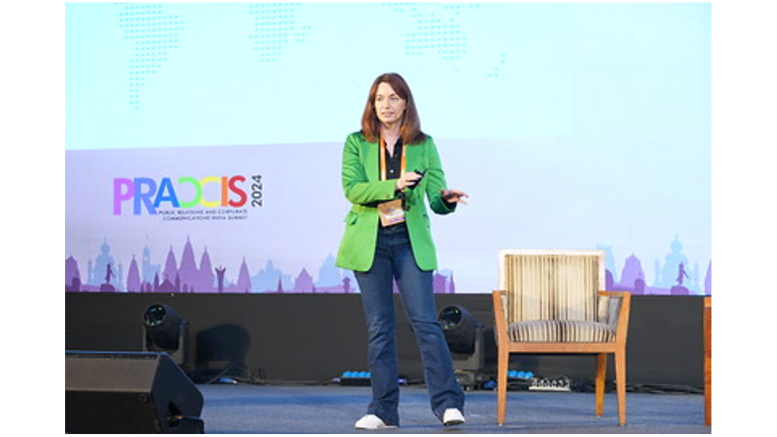Creativity is one of the essential skills in Public Relations and helps professionals – to think out-of-the box, develop innovative strategies to stand apart in a crowded landscape. By blending creativity into their work, PR professionals can orchestrate compelling narratives, design engaging campaigns & also build meaningful connections with their audience. Ultimately, creativity is actually the foundation upon which effective PR is built – allowing professionals to remain relevant, adapt to changing times & ultimately achieve their goals.
At PRAXIS11, Sarah Meron, Chief Communications Officer at IBM, delivered an insightful session on the vital role of creativity in Public Relations and Communications. Discussing the topic “Creativity is the Bedrock of Good Public Relations” Sarah shared that creativity can solve problems. She emphasised that creativity is the driving force behind successful PR, allowing professionals to stand out, craft compelling narratives and develop innovative strategies in an increasingly crowded media landscape.
Creativity: The Core of Problem-Solving
“Creativity is how you solve problems. It’s a unique human trait,” Sarah remarked. In her view, creativity is not just about flashy campaigns but about addressing complex challenges in novel ways. She broke down communication roles into three key functions:
- Distiller: Simplifying or distilling messages rather than summarising them – to create clarity. Sarah shared how IBM shifted its communication strategy from complex messages to concise narratives, turning headlines from “Avoid IBM Stock” to “IBM Reaches Record High.”
- Fortune Teller: Anticipating market trends and opportunities. Sarah explained how communicators act as “fortune tellers,” predicting and shaping future markets, particularly as IBM focuses on AI, cloud computing, and blockchain. “We as fortune-tellers have the capacity to fortune-tell and even make a market before it exists,” she noted.
- Therapist: Understanding human psychology and audience reactions, helping communicators align messaging with what people truly want to hear. It’s about how do we leverage human psychology.
In a dialogue with Atul Sharma, CEO of Ruder Finn India & President, PRCAI, Sarah explored the idea of whether creativity is inborn or can be nurtured. “You can’t go to a class to learn creativity, it has to come naturally,” she asserted, though she emphasised that creating the right environment is essential for fostering creative thinking. Sarah encouraged professionals to “think expansively” and experiment with ideas, even if some might fail.
Technology and Creativity: Friend or Foe?
When asked if technology is killing creativity, Sarah had a refreshing take: “Tech might do the ppts for us, but the broad range of ideas only comes from people!” She explained that while technology enhances productivity, the creative spark still belongs to humans. For IBM, creativity, driven by its diverse global community, remains at the core of its communications strategy.
The Importance of Trusting Data and Gut Instinct
Sarah also stressed the balance between data-driven strategies and intuition. While data is crucial, she believes that trusting one’s gut is equally important in PR. “You can’t shy away from data, but you’ve got to trust your gut too!” she said, offering a reminder that creativity often lies at the intersection of analysis and instinct.
Advice for Young PR Professionals
Sarah’s closing advice to young professionals was simple yet impactful: “Listen more, start creating environments for creativity, and don’t be afraid of bad ideas.” She highlighted the importance of fostering a culture where creative solutions can thrive, even if they don’t always work out!
The views and opinions published here belong to the author and do not necessarily reflect the views and opinions of the publisher.






Be the first to comment on "Creativity in PR: Sarah Meron on Problem Solving, Innovation & Human Connection"